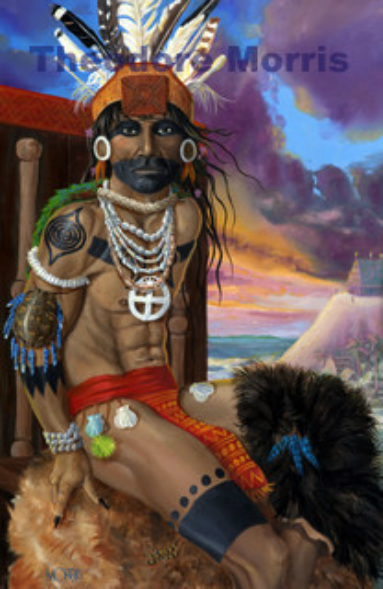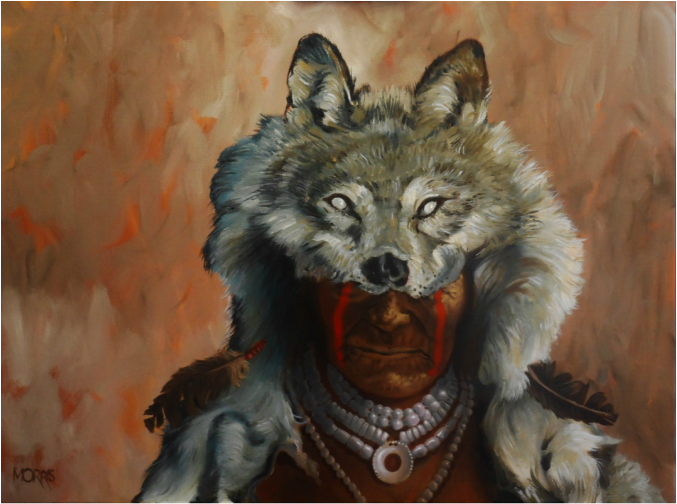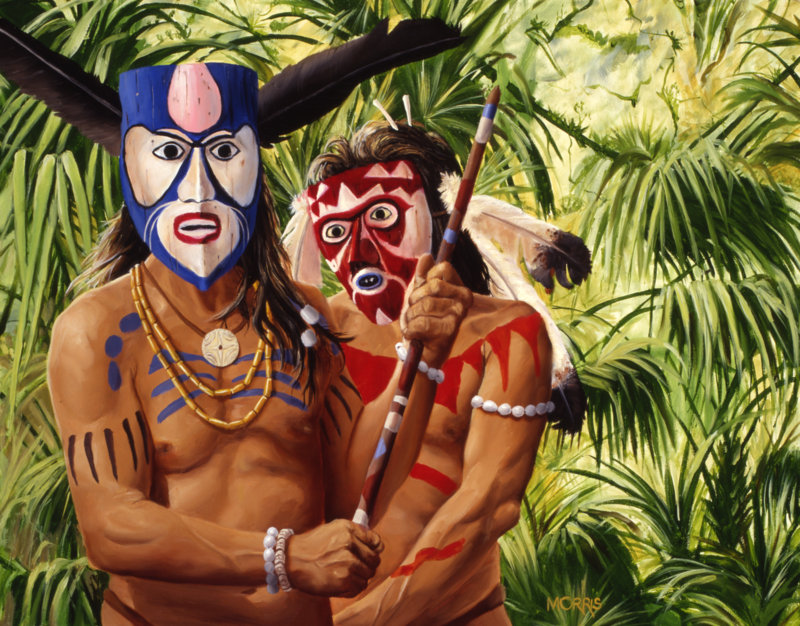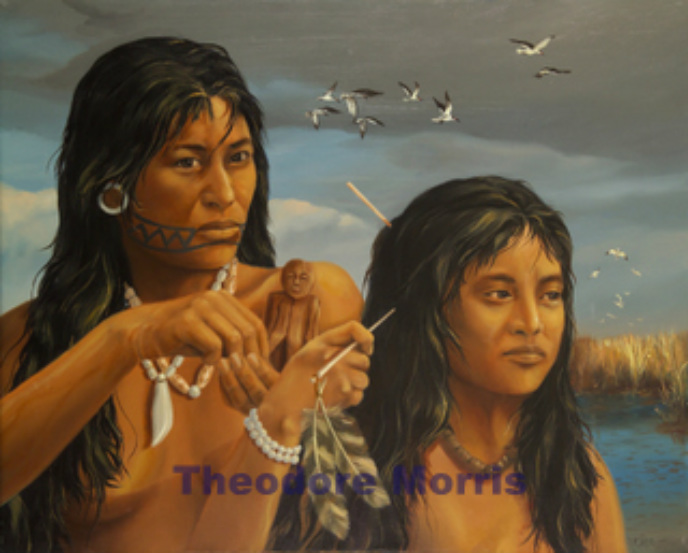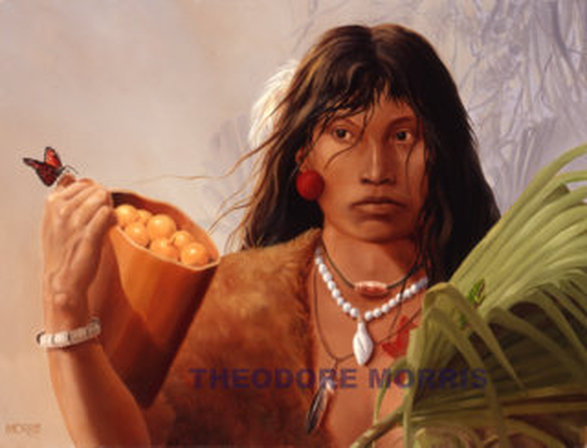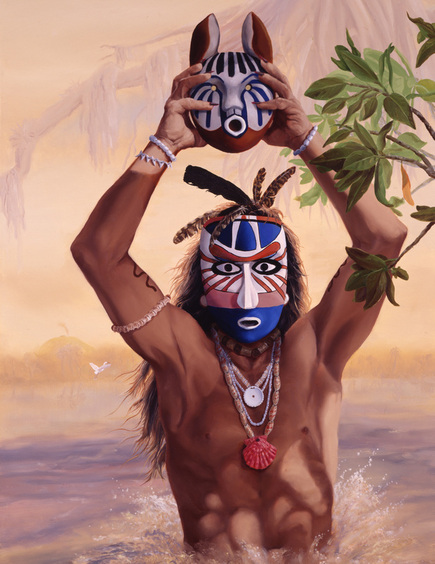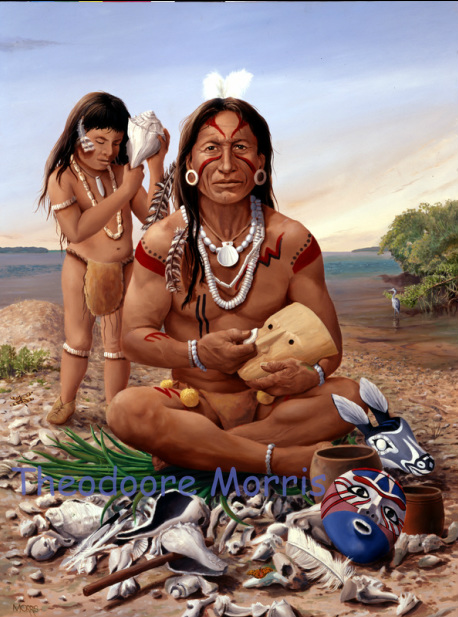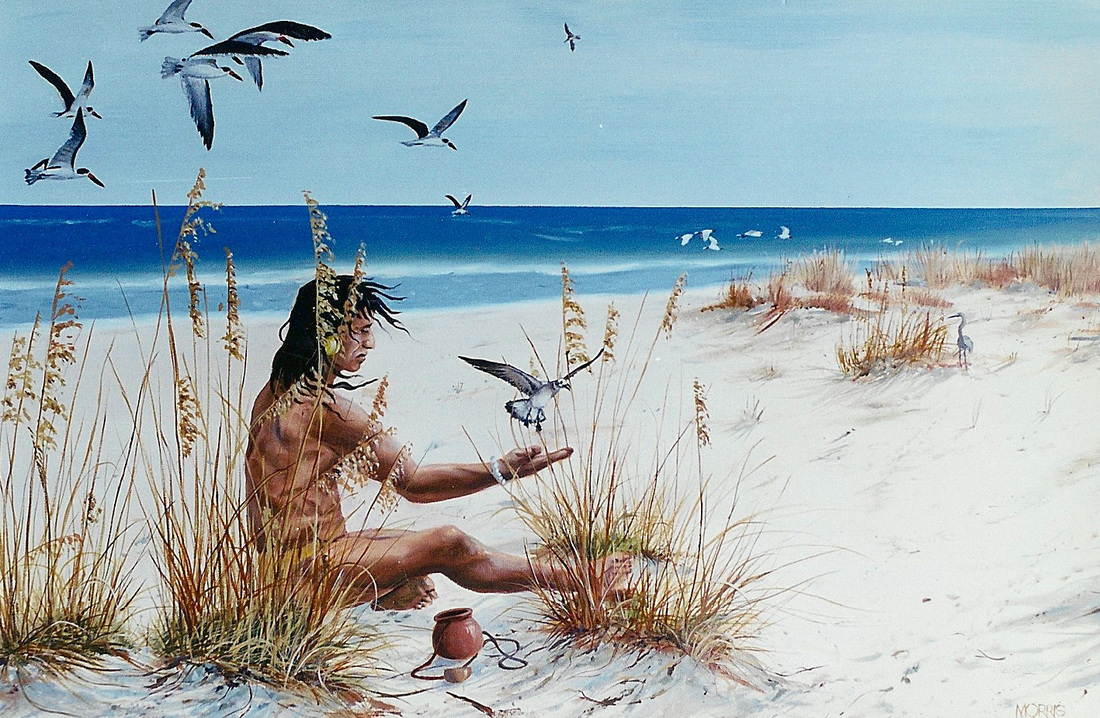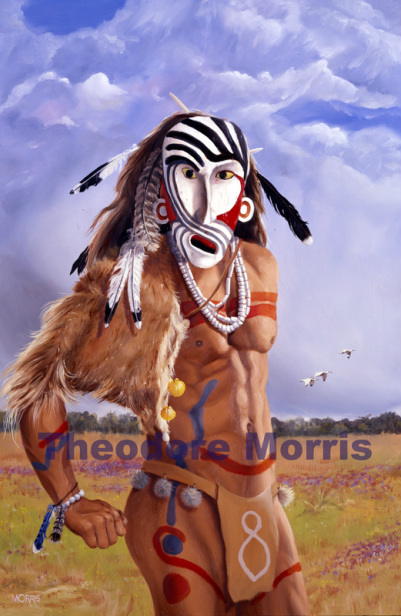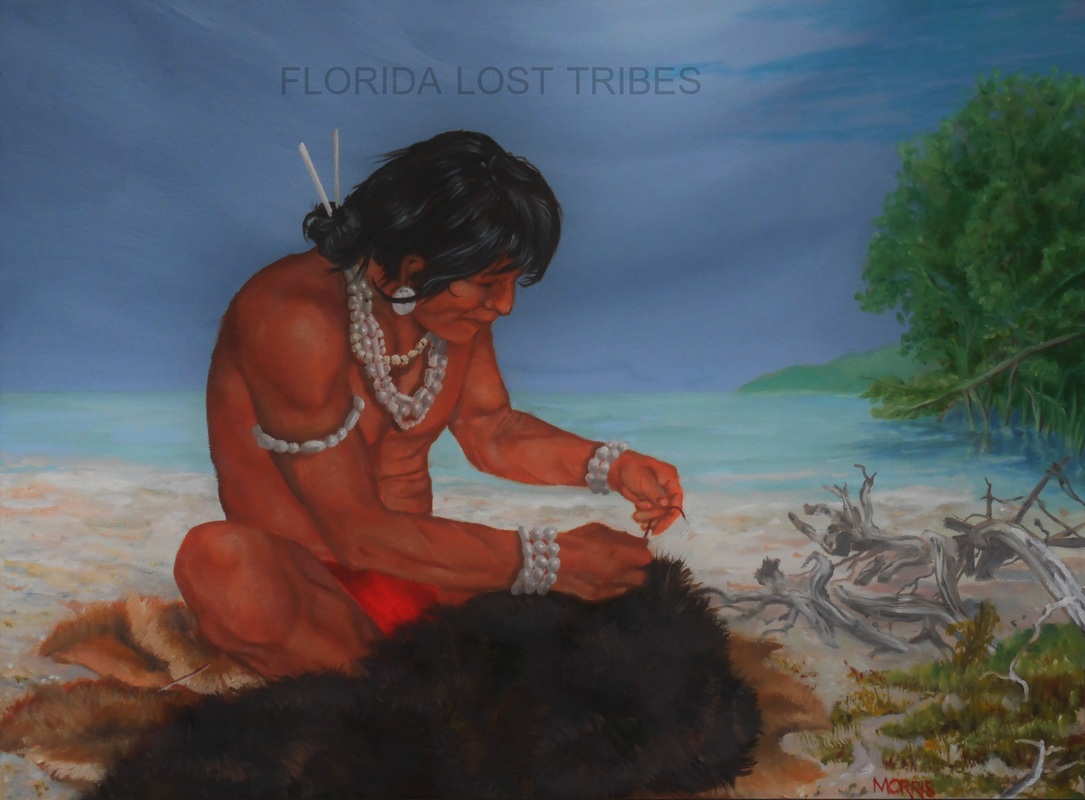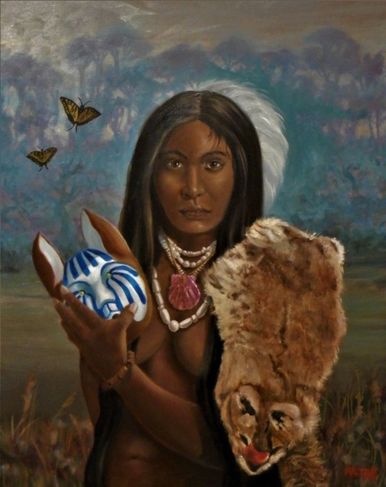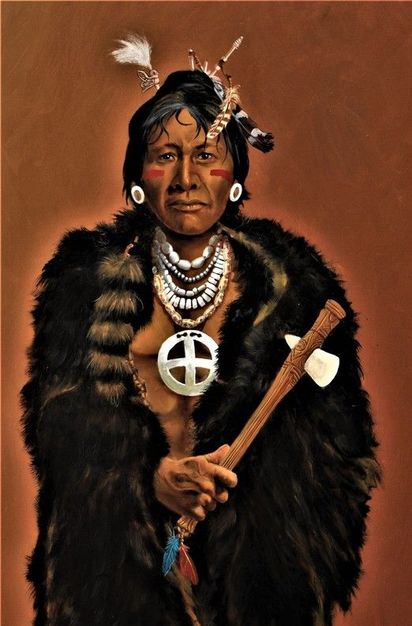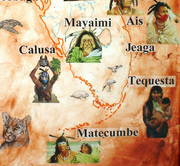
Calusa Written accounts by Spanish missionaries, shipwreck survivors, and chroniclers help us to imagine the Calusa people who built and lived upon the massive artificial shell constructions of southwestern Florida. The cultural traditions of the Calusa were deeply rooted in Estero Bay, Charlotte Harbor and neighboring areas. Major archaeological sites are characterized by their large size, and a diverse arrangement of shell mounds, sand mounds, shellworks, canals, and other features, and include places like Useppa Island, Pineland, and Mound Key.
These were major towns—centers of political, economic, and religious power—though evidence of aboriginal occupation is abundant on the landscape, and includes a host of family camps for shellfishing, fishing, and other procurement activities, as well as satellite communities. Archaeologists have documented nearly 80 ancient archaeological sites within the boundaries of the Charlotte Harbor Preserve State Park—with many more in the surrounding area. Relying on aquatic resources, the Calusa developed into a powerful, tributary chiefdom prior to the arrival of the Spanish in the sixteenth century, and occasionally expanded their reign to include other southern Florida tribes. The Calusa strongly resisted two Spanish mission attempts—one in 1566 and another in 1697—and persisted in many of their traditional ways into the eighteenth century. In fact, Juan Ponce de Leon mentions a hostile encounter with the Calusa in 1513 and was fatally wounded by a Calusa arrow in 1521. Despite their resistance to Spanish control, the Calusa participated in an extensive exchange in European goods, which were introduced through shipwreck salvage and trade, frequently incorporating these items into traditional exchange networks, and added to patterns of costume and adornment.
These were major towns—centers of political, economic, and religious power—though evidence of aboriginal occupation is abundant on the landscape, and includes a host of family camps for shellfishing, fishing, and other procurement activities, as well as satellite communities. Archaeologists have documented nearly 80 ancient archaeological sites within the boundaries of the Charlotte Harbor Preserve State Park—with many more in the surrounding area. Relying on aquatic resources, the Calusa developed into a powerful, tributary chiefdom prior to the arrival of the Spanish in the sixteenth century, and occasionally expanded their reign to include other southern Florida tribes. The Calusa strongly resisted two Spanish mission attempts—one in 1566 and another in 1697—and persisted in many of their traditional ways into the eighteenth century. In fact, Juan Ponce de Leon mentions a hostile encounter with the Calusa in 1513 and was fatally wounded by a Calusa arrow in 1521. Despite their resistance to Spanish control, the Calusa participated in an extensive exchange in European goods, which were introduced through shipwreck salvage and trade, frequently incorporating these items into traditional exchange networks, and added to patterns of costume and adornment.
Carlos, King of The Calusa
In 1566 Pedro Menendez de Aviles described a town of 4,000 men and women and the chief's house on the highest mound that held 2,000 people. My use of a dramatic colorful sunset represents the tragedy that is about to befall the Calusa people with the arrival of the Spanish. I have Carlos gazing directly at the viewer in a confrontational manner.
ARTIFACTS & OBJECTS
· Assorted feathers
· Bone hairpins
· Woven head crown
· Carved wood plaque
· Moss Verbena flowers
· Carved & painted wood chair
· Face & body paint
· Shell ear decorations with wood insert & feather attachments
· Feather cape made from the Painted Bunting bird
· Shell & bone bead necklaces
· Whelk shell gorget
· Box Turtle with Bluejay feathers
· Cloth belt with shell and Cottonwood ball attachments
· Bear skin
· Painted woven breech cloth
· Deer pelt
“Caalus, which the Spaniards mispronouncing the word, called him Carlos...is the greatest of the caciques that there is in all of Florida.”
(Juan Rogel, Jesuit missionary, 1567)
ARTIFACTS & OBJECTS
· Assorted feathers
· Bone hairpins
· Woven head crown
· Carved wood plaque
· Moss Verbena flowers
· Carved & painted wood chair
· Face & body paint
· Shell ear decorations with wood insert & feather attachments
· Feather cape made from the Painted Bunting bird
· Shell & bone bead necklaces
· Whelk shell gorget
· Box Turtle with Bluejay feathers
· Cloth belt with shell and Cottonwood ball attachments
· Bear skin
· Painted woven breech cloth
· Deer pelt
“Caalus, which the Spaniards mispronouncing the word, called him Carlos...is the greatest of the caciques that there is in all of Florida.”
(Juan Rogel, Jesuit missionary, 1567)
Gray Wolf Clan Leader
Wolves are used in the mythology of nearly every Native American tribe. They are associated with courage, strength, loyalty, and success in hunting. Wolves are also the most common clan animals and like bears, they are considered closely related to humans. I painted the canvas using warm colors contrasted with cool colors. The man's face is created by using very warm pigments as contrasted to the wolf, who has cool colors. This produces visual movements.
ARTIFACTS & OBJECTS
Indians had taken the position, having made a very strong barricade, and within it there were many Indian braves, painted red...”
(Rodrigo Rangel, member of the de Soto's expedition, 1539
ARTIFACTS & OBJECTS
- Gray wolf (Canis lupus) skin with shell eyes
- Face paint
- Shell beads
- Carved shell pendant
- Hawk feathers
Indians had taken the position, having made a very strong barricade, and within it there were many Indian braves, painted red...”
(Rodrigo Rangel, member of the de Soto's expedition, 1539
High Priests
Priests wore masks described by Spanish Jesuits in 1567 as "horrible," which were kept in a temple built on top of a special mound. Although the masks played an important role in the Calusa culture, their exact purpose is not known. I painted these priests immersed in their lush subtropical environment.
OBJECTS & ARTIFACTS
OBJECTS & ARTIFACTS
- Cormorant feather
- Carved, painted wood masks
- Copper bead necklace
- Shell hair beads
- Body paint
- Shell & bone bracelets
- Carved bone hairpins
Calusa Girls
Following a warm summer rain, two girls prepare for a tribal ceremony on Florida's lower west coast. The older girl is holding a wood figurine which may have had religious significance. The younger girl is playing with her sister's bone hairpin adorned with Hawk feathers.
ARTIFACTS & OBJECTS
(Frank Hamilton Cushing, archaeologist, 1896)
ARTIFACTS & OBJECTS
- Shell & wood ear ornament
- Facial tattoo
- Shell bead necklace with carved welk shell pendant
- Olive shell necklace
- Bone bead necklace
- Bone hairpin with Hawk feathers
- Pearl bracelet
- Carved wood figurine
(Frank Hamilton Cushing, archaeologist, 1896)
Bride of Carlos
It was the custom of the Calusa chief to have more than one wife. Marrying a woman from outside the Calusa tribe insured peace between these other tribes. I used the blue background along with the mysterious forest to convey a sense of drama. She wears all her splendid finery to impress her new husband.
ARTIFACTS & OBJECTS
“Oathcaqua was conducting one of his exceedingly beautiful daughters to King Carlos to give her to him for his wife, according to the custom of the country.”
(Rene de Laudonniere, 1564)
ARTIFACTS & OBJECTS
- Bear robe with feathers
- Forehead shell disc
- Face paint
- Shell beads
- Queen butterfly
- Body paint
- Shell bead armbands & wristbands with feathers
- Cottonwood ball attachments
- Painted deerskin
- Woven Spanish Moss skirt
“Oathcaqua was conducting one of his exceedingly beautiful daughters to King Carlos to give her to him for his wife, according to the custom of the country.”
(Rene de Laudonniere, 1564)
Preparation For The Feast
This young woman, who has adorned herself with body paint that signifies that she is a member of royalty and has put on her finest jewels, prepares for a feast by gathering hog plumes in a carved wooden tub. The lifestyle of the Calusa was leisurely, and they enjoyed numerous celebrations and feasts, many of which were connected to religious ceremonies at which lavish meals were prepared.
- ARTIFACTS & OBJECTS
- Racoon tail
- Fish bladder ear decorations
- Body tattoos
- Wood spear with bone tip
- Shell bead necklace
- Shell pendant
- Shell bead bracelet
- Bald Eagle
- Monarch & Julia butterflies
" These people are able to sustain themselves solely with the abundance of fish that they catch and some wild fruits."
(Juan de Carmenatri, 1693 )
(Juan de Carmenatri, 1693 )
Ceremonial Secrets at Mound Key
After coming down from a mound temple, this high Calusa priest prepares himself to participate in a secret ceremony. The masks were representative of the mystical, compelling, and sacred powers believed to be possessed by these important principle men of the Calusa culture. The design of the masks were taken from actual masks recovered during the Frank Hamilton Cushing expedition in 1896 at Key Marco, near Naples.
ARTIFACTS & OBJECTS
ARTIFACTS & OBJECTS
- Carved & painted wood masks
- Assorted bird feathers
- Carved and painted wood masks
- Shell bead bracelets
- Shark-tooth bracelet
- Shell beads with carved shell pendant
- Olive shell beads with Cat's Paw shell pendant
"...by their conversation, I discovered that baptism was not lawful for them,--they were heretics; andsince then it appears they have returned to their old ways, and are more wicked than they were formerly."
Hernando Escalante de Fontaneda, 1565
Hernando Escalante de Fontaneda, 1565
Mask Maker
This painting shows a sacred wood carver suddenly looking up to confront the viewer while his daughter looks on. He sits on the shore at Mound Key which is located in Estero Bay just south of Ft. Myers. By painting all the materials needed to carve these beautiful spiritual items, I have connected the relationship between their environment and their culture. The painting is the main focus of a video produced by the Florida Anthropological Society.
ARTIFACTS & OBJECTS
MAN
“Some Indians donned and went out into the village with them...They even attempted to climb up to our fort to hold a procession with their masks...a little valley where they were accustomed to promenade in view of the people with the ceremony.”
(Juan Rogel,1566)
ARTIFACTS & OBJECTS
MAN
- Egret plumes
- Shell & wood ear ornaments
- Carved Whelk shell pendant
- Shell & bone bead necklaces
- Turkey feathers
- Shell & pearl bead bracelets
- Tassels made from Cottonwood tree fibers
- Deerskin loincloth
- Pearl ankle band
- CHILD
- Turkey feather
- Whelk shell pendant
- Olive shell pendant
- Shell bead arm & leg bands
“Some Indians donned and went out into the village with them...They even attempted to climb up to our fort to hold a procession with their masks...a little valley where they were accustomed to promenade in view of the people with the ceremony.”
(Juan Rogel,1566)
Beach Friends
Sacred Rain
The Calusa believed that there were three gods who ruled the world. The greatest and most powerful god controlled the weather, sun, moon, and stars. Elaborate carved wood masks were part of Calusa pageantry. To emphasize the strength of this Shaman, I placed him in bright sunlight in contrast to the dark squall line approaching.
ARTIFACTS & OBJECTS
ARTIFACTS & OBJECTS
- Bone hairpins
- Carved & painted wood mask
- Seagull, Cormorant, and Hawk feathers
- Shell & wood ear ornaments
- Bone necklace
- Shell bead necklace
- Deer hide mantle
- Body paint
- Painted shells
- Buckskin loincloth
- Tassels made from finely spun cords of dyed cottonwood tree down
- Bluejay & Pheasant feathers
- Pearl bracelet
- White Ibis bird
After The Storm
The Calusa craftsman enjoys the cool breezes after a summer storm, while working on a bear skin robe. The most abundant skins were of deer, which he is sitting on. I painted the steel blue-colored sky to contrast with the warm skin tones of the figure.
ARTIFACTS & OBJECTS
ARTIFACTS & OBJECTS
- Bone hairpins
- Shell ear decoration
- Shell beads
- Dyed deerskin loincloth
- Bear & deer skins
Two Bobcats
